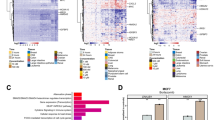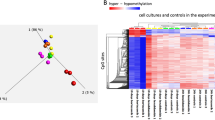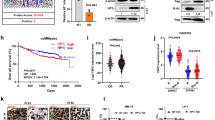Abstract
Global change in protein turnover (protein degradome) constitutes a central part of cellular responses to intrinsic or extrinsic stimuli. However, profiling protein degradome remains technically challenging. Recently, inhibition of the proteasome, e.g., by using bortezomib (BTZ), has emerged as a major chemotherapeutic strategy for treating multiple myeloma and other human malignancies, but systematic understanding of the mechanisms for BTZ drug action and tumor drug resistance is yet to be achieved. Here we developed and applied a dual-fluorescence-based Protein Turnover Assay (ProTA) to quantitatively profile global changes in human protein degradome upon BTZ-induced proteasomal inhibition. ProTA and subsequent network analyses delineate potential molecular basis for BTZ action and tumor drug resistance in BTZ chemotherapy. Finally, combined use of BTZ with drugs targeting the ProTA-identified key genes or pathways in BTZ action reduced BTZ resistance in multiple myeloma cells. Remarkably, BTZ stabilizes proteasome subunit PSMC1 and proteasome assembly factor PSMD10, suggesting a previously under-appreciated mechanism for regulating proteasome homeostasis. Therefore, ProTA is a novel tool for profiling human protein degradome to elucidate potential mechanisms of drug action and resistance, which might facilitate therapeutic development targeting proteostasis to treat human disorders.
Similar content being viewed by others
Log in or create a free account to read this content
Gain free access to this article, as well as selected content from this journal and more on nature.com
or
References
Diaz LA Jr, Williams RT, Wu J, et al. The molecular evolution of acquired resistance to targeted EGFR blockade in colorectal cancers. Nature 2012; 486:537–540.
Soon WW, Hariharan M, Snyder MP . High-throughput sequencing for biology and medicine. Mol Syst Biol 2013; 9:640.
Wacker SA, Houghtaling BR, Elemento O, Kapoor TM . Using transcriptome sequencing to identify mechanisms of drug action and resistance. Nat Chem Biol 2012; 8:235–237.
Vabulas RM, Hartl FU . Protein synthesis upon acute nutrient restriction relies on proteasome function. Science 2005; 310:1960–1963.
Finley D, Ciechanover A, Varshavsky A . Ubiquitin as a central cellular regulator. Cell 2004; 116:S29–S32.
Hershko A, Ciechanover A . The ubiquitin system. Annu Rev Biochem 1998; 67:425–479.
Powers ET, Morimoto RI, Dillin A, Kelly JW, Balch WE . Biological and chemical approaches to diseases of proteostasis deficiency. Annu Rev Biochem 2009; 78:959–991.
Haendler B, Jentsch S . The ubiquitin system in health and disease. Preface. Ernst Schering Found Symp Proc 2008; 1:V–VI.
Hoeller D, Dikic I . Targeting the ubiquitin system in cancer therapy. Nature 2009; 458:438–444.
Ang XL, Harper JW . A road map of cellular protein homeostasis. Nat Chem Biol 2009; 5:9–11.
Yen HC, Xu Q, Chou DM, Zhao Z, Elledge SJ . Global protein stability profiling in mammalian cells. Science 2008; 322:918–923.
Yewdell JW, Lacsina JR, Rechsteiner MC, Nicchitta CV . Out with the old, in with the new? Comparing methods for measuring protein degradation. Cell Biol Int 2011; 35:457–462.
Shaner NC, Steinbach PA, Tsien RY . A guide to choosing fluorescent proteins. Nat Methods 2005; 2:905–909.
Emanuele MJ, Elia AE, Xu Q, et al. Global identification of modular cullin-RING ligase substrates. Cell 2011; 147:459–474.
Khmelinskii A, Keller PJ, Bartosik A, et al. Tandem fluorescent protein timers for in vivo analysis of protein dynamics. Nat Biotechnol 2012; 30:708–714.
Komar AA, Hatzoglou M . Cellular IRES-mediated translation: the war of ITAFs in pathophysiological states. Cell Cycle 2011; 10:229–240.
Walsh CT, Garneau-Tsodikova S, Gatto GJ Jr . Protein posttranslational modifications: the chemistry of proteome diversifications. Angew Chem Int Ed Engl 2005; 44:7342–7372.
Piatkov KI, Brower CS, Varshavsky A . The N-end rule pathway counteracts cell death by destroying proapoptotic protein fragments. Proc Natl Acad Sci USA 2012; 109:E1839–E1847.
Varshavsky A . The N-end rule pathway and regulation by proteolysis. Protein Sci 2011; 20:1298–1345.
Tasaki T, Sriram SM, Park KS, Kwon YT . The N-end rule pathway. Annual Rev Biochem 2012; 81:261–289.
Varshavsky A . Three decades of studies to understand the functions of the ubiquitin family. Methods Mol Biol 2012; 832:1–11.
Verma R, Oania RS, Kolawa NJ, Deshaies RJ . Cdc48/p97 promotes degradation of aberrant nascent polypeptides bound to the ribosome. Elife 2013; 2:e00308.
Turner GC, Varshavsky A . Detecting and measuring cotranslational protein degradation in vivo. Science 2000; 289:2117–2120.
Brower CS, Piatkov KI, Varshavsky A . Neurodegeneration-associated protein fragments as short-lived substrates of the N-end rule pathway. Mol Cell 2013; 50:161–171.
Hwang CS, Varshavsky A . Regulation of peptide import through phosphorylation of Ubr1, the ubiquitin ligase of the N-end rule pathway. Proc Natl Acad Sci USA 2008; 105:19188–19193.
Goldberg AL . Development of proteasome inhibitors as research tools and cancer drugs. J Cell Biol 2012; 199:583–588.
Chen D, Frezza M, Schmitt S, Kanwar J, Dou QP . Bortezomib as the first proteasome inhibitor anticancer drug: current status and future perspectives. Curr Cancer Drug Targets 2011; 11:239–253.
Richardson PG, Barlogie B, Berenson J, et al. A phase 2 study of bortezomib in relapsed, refractory myeloma. N Engl J Med 2003; 348:2609–2617.
Richardson PG, Weller E, Lonial S, et al. Lenalidomide, bortezomib, and dexamethasone combination therapy in patients with newly diagnosed multiple myeloma. Blood 2010; 116:679–686.
Ruschak AM, Slassi M, Kay LE, Schimmer AD . Novel proteasome inhibitors to overcome bortezomib resistance. J Natl Cancer Inst 2011; 103:1007–1017.
Bachmair A, Finley D, Varshavsky A . In vivo half-life of a protein is a function of its amino-terminal residue. Science 1986; 234:179–186.
Varshavsky A . Ubiquitin fusion technique and related methods. Methods Enzymol 2005; 399:777–799.
Shimoji T, Murakami K, Sugiyama Y, et al. Identification of annexin A1 as a novel substrate for E6AP-mediated ubiquitylation. J Cell Biochem 2009; 106:1123–1135.
Hu RG, Sheng J, Qi X, Xu Z, Takahashi TT, Varshavsky A . The N-end rule pathway as a nitric oxide sensor controlling the levels of multiple regulators. Nature 2005; 437:981–986.
An JY, Seo JW, Tasaki T, Lee MJ, Varshavsky A, Kwon YT . Impaired neurogenesis and cardiovascular development in mice lacking the E3 ubiquitin ligases UBR1 and UBR2 of the N-end rule pathway. Proc Natl Acad Sci USA 2006; 103:6212–6217.
Lee PC, Sowa ME, Gygi SP, Harper JW . Alternative ubiquitin activation/conjugation cascades interact with N-end rule ubiquitin ligases to control degradation of RGS proteins. Mol Cell 2011; 43:392–405.
Rual JF, Hirozane-Kishikawa T, Hao T, et al. Human ORFeome version 1.1: a platform for reverse proteomics. Genome Res 2004; 14:2128–2135.
Dennis G Jr, Sherman BT, Hosack DA, et al. DAVID: Database for Annotation, Visualization, and Integrated Discovery. Genome Biol 2003; 4:P3.
Thomas PD, Kejariwal A, Campbell MJ, et al. PANTHER: a browsable database of gene products organized by biological function, using curated protein family and subfamily classification. Nucleic Acids Res 2003; 31:334–341.
Bader GD, Cary MP, Sander C . Pathguide: a pathway resource list. Nucleic Acids Res 2006; 34:D504–D506.
Lioni M, Noma K, Snyder A, et al. Bortezomib induces apoptosis in esophageal squamous cell carcinoma cells through activation of the p38 mitogen-activated protein kinase pathway. Mol Cancer Ther 2008; 7:2866–2875.
Hallek M, Bergsagel PL, Anderson KC . Multiple myeloma: increasing evidence for a multistep transformation process. Blood 1998; 91:3–21.
Oyajobi BO, Garrett IR, Gupta A, et al. Stimulation of new bone formation by the proteasome inhibitor, bortezomib: implications for myeloma bone disease. Br J Haematol 2007; 139:434–438.
Hanahan D, Weinberg RA . Hallmarks of cancer: the next generation. Cell 2011; 144:646–674.
Deberardinis RJ, Thompson CB . Cellular metabolism and disease: what do metabolic outliers teach us? Cell 2012; 148:1132–1144.
Barabasi AL, Oltvai ZN . Network biology: understanding the cell's functional organization. Nat Rev Genet 2004; 5:101–113.
Szklarczyk D, Franceschini A, Kuhn M, et al. The STRING database in 2011: functional interaction networks of proteins, globally integrated and scored. Nucleic Acids Res 2011; 39:D561–D568.
Hou J, Lin FY, Zhang B, Zhang LZ, Ding SQ . Establishment and biological characteristics of human multiple myeloma cell line CZ-1. Chin Med J (Engl) 2004; 117:115–119.
Menendez JA, Lupu R . Fatty acid synthase and the lipogenic phenotype in cancer pathogenesis. Nat Rev Cancer 2007; 7:763–777.
Hanna J, Meides A, Zhang DP, Finley D . A ubiquitin stress response induces altered proteasome composition. Cell 2007; 129:747–759.
Aiken CT, Kaake RM, Wang X, Huang L . Oxidative stress-mediated regulation of proteasome complexes. Mol Cell Proteomics 2011; 10:R110.006924.
Radhakrishnan SK, Lee CS, Young P, Beskow A, Chan JY, Deshaies RJ . Transcription factor Nrf1 mediates the proteasome recovery pathway after proteasome inhibition in mammalian cells. Mol Cell 2010; 38:17–28.
Kwak MK, Kensler TW . Induction of 26S proteasome subunit PSMB5 by the bifunctional inducer 3-methylcholanthrene through the Nrf2-ARE, but not the AhR/Arnt-XRE, pathway. Biochem Biophys Res Commun 2006; 345:1350–1357.
Oerlemans R, Franke NE, Assaraf YG, et al. Molecular basis of bortezomib resistance: proteasome subunit beta5 (PSMB5) gene mutation and overexpression of PSMB5 protein. Blood 2008; 112:2489–2499.
Lichter DI, Danaee H, Pickard MD, et al. Sequence analysis of beta-subunit genes of the 20S proteasome in patients with relapsed multiple myeloma treated with bortezomib or dexamethasone. Blood 2012; 120:4513–4516.
Tomko RJ Jr, Funakoshi M, Schneider K, Wang J, Hochstrasser M . Heterohexameric ring arrangement of the eukaryotic proteasomal ATPases: implications for proteasome structure and assembly. Mol Cell 2010; 38:393–403.
Xie Y . Structure, assembly and homeostatic regulation of the 26S proteasome. J Mol Cell Biol 2010; 2:308–317.
Ravid T, Hochstrasser M . Diversity of degradation signals in the ubiquitin-proteasome system. Nat Rev Mol Cell Biol 2008; 9:679–690.
Geng F, Wenzel S, Tansey WP . Ubiquitin and proteasomes in transcription. Annu Rev Biochem 2012; 81:177–201.
Obeng EA, Carlson LM, Gutman DM, Harrington WJ Jr, Lee KP, Boise LH . Proteasome inhibitors induce a terminal unfolded protein response in multiple myeloma cells. Blood 2006; 107:4907–4916.
Heinrich PC, Behrmann I, Muller-Newen G, Schaper F, Graeve L . Interleukin-6-type cytokine signalling through the gp130/Jak/STAT pathway. Biochem J 1998; 334:297–314.
Yao Z, Fenoglio S, Gao DC, et al. TGF-beta IL-6 axis mediates selective and adaptive mechanisms of resistance to molecular targeted therapy in lung cancer. Proc Natl Acad Sci USA 2010; 107:15535–15540.
Kuhn M, Szklarczyk D, Franceschini A, et al. STITCH 2: an interaction network database for small molecules and proteins. Nucleic Acids Res 2010; 38:D552–D556.
Landowski TH, Megli CJ, Nullmeyer KD, Lynch RM, Dorr RT . Mitochondrial-mediated disregulation of Ca2+ is a critical determinant of Velcade (PS-341/bortezomib) cytotoxicity in myeloma cell lines. Cancer Res 2005; 65:3828–3836.
Taipale M, Jarosz DF, Lindquist S . HSP90 at the hub of protein homeostasis: emerging mechanistic insights. Nat Rev Mol Cell Biol 2010; 11:515–528.
Chou TC, Talalay P . Quantitative analysis of dose-effect relationships: the combined effects of multiple drugs or enzyme inhibitors. Adv Enzyme Regul 1984; 22:27–55.
Mardis ER . Next-generation DNA sequencing methods. Annu Rev Genomics Hum Genet 2008; 9:387–402.
Schlachter C, Lisdat F, Frohme M, et al. Pushing the detection limits: the evanescent field in surface plasmon resonance and analyte-induced folding observation of long human telomeric repeats. Biosens Bioelectron 2012; 31:571–574.
Conze D, Weiss L, Regen PS, et al. Autocrine production of interleukin 6 causes multidrug resistance in breast cancer cells. Cancer Res 2001; 61:8851–8858.
Chauhan D, Singh AV, Ciccarelli B, Richardson PG, Palladino MA, Anderson KC . Combination of novel proteasome inhibitor NPI-0052 and lenalidomide trigger in vitro and in vivo synergistic cytotoxicity in multiple myeloma. Blood 2010; 115:834–845.
Alberti S, Gitler AD, Lindquist S . A suite of Gateway cloning vectors for high-throughput genetic analysis in Saccharomyces cerevisiae. Yeast 2007; 24:913–919.
Lamesch P, Li N, Milstein S, et al. hORFeome v3.1: a resource of human open reading frames representing over 10 000 human genes. Genomics 2007; 89:307–315.
Acknowledgements
We are grateful to Dr W Bian and her team in Cell Biology Core facility of SIBCB for their excellent support in flow cytometry analysis and cell sorting, and Drs L Lin, Y Xia and H Xiao of National Center for Microarrays for their help in microarray analysis. We are particularly grateful to Dr Hsueh-Chi Yen at Institute of Mol Biol, Academia Sinica, and Dr Ivan Dikic of Goethe University for advice, and Drs Dangsheng Li, Lijian Hui and Jiarui Wu of SIBCB, and Dr Shirley Diamond of California Institute of Technology for helpful discussion. We also thank Dr Ya-lan Wu and all other members of the Hu lab for support. This work was supported by the National Natural Science Foundation of China (31270828, 31070678, 81170491, 81072070 and 81470360), the 100 Talents award from CAS to RH and the Ministry of Science and Technology, China (2010CB912100, 2012CB910800 and 2013CB910900 to RH, and 2011CB915501 to KR). RH was also supported by a Sanofi-aventis SIBS Young Investigator award and funding from the Cancer Center of Xuhui Central Hospital (CCR2012003), Shanghai Institute of Neurosciences (SKLN-201206) and the Instrument Developing Project of the Chinese Academy of Sciences (YZ201339).
Author information
Authors and Affiliations
Corresponding authors
Additional information
( Supplementary information is linked to the online version of the paper on the Cell Research website.)
Supplementary information
Supplementary information, Figure S1
Immunoblotting analysis confirmed bortezomib induced changes in stability of individual fusion proteins. (PDF 608 kb)
Supplementary information, Figure S2
Immunoblotting analysis confirmed bortezomib-induced changes in stability of endogenous proteins. (PDF 542 kb)
Supplementary information, Figure S3
Categorization of bortezomib-induced changes in global protein stability. (PDF 478 kb)
Supplementary information, Figure S4
Protein-protein interaction (PPI) network analysis of bortezomib-induced changes in protein stability. (PDF 392 kb)
Supplementary information, Figure S5
Characterization of BTZ-sensitive cells (CZ-1) or BTZ-resistant cells (CZ-1/R) from a multiple myeloma (MM) patient48. (PDF 375 kb)
Supplementary information, Figure S6
(A) The stability of PSMC1 and PSMD10 were assayed by cycloheximide (CHX) chase in CZ-1 cells. (PDF 871 kb)
Supplementary information, Figure S7
Categorization of bortezomib-induced changes in gene transcriptions. (PDF 427 kb)
Supplementary information, Figure S8
Protein-protein interaction (PPI) network analysis of bortezomib-induced changes in gene transcriptions. (PDF 258 kb)
Supplementary information, Figure S9
Chemical-protein interaction (CPI) network analysis of bortezomib induced changes in protein stability. (PDF 234 kb)
Supplementary information, Figure S10
Combined chemotherapy using BTZ and drugs that targeted the ProTA identified key genes (PDF 302 kb)
Supplementary information, Figure S11
C75, 17-AAG and BTZ exhibit synergistic, cytotoxic effects on the MM cell line CZ-1 (PDF 292 kb)
Supplementary information, Table S1
Annotations for the genes whose symbols were frequently used in this work (XLSX 19 kb)
Supplementary information, Table S2
A complete list of the ProTA-identified protein stability profiles in 293FT cells treated with or without bortezomib (XLSX 2287 kb)
Supplementary information, Data S1
Materials and Methods (PDF 265 kb)
Rights and permissions
About this article
Cite this article
Yu, T., Tao, Y., Yang, M. et al. Profiling human protein degradome delineates cellular responses to proteasomal inhibition and reveals a feedback mechanism in regulating proteasome homeostasis. Cell Res 24, 1214–1230 (2014). https://doi.org/10.1038/cr.2014.122
Received:
Revised:
Accepted:
Published:
Issue date:
DOI: https://doi.org/10.1038/cr.2014.122



